Explore Arches National Park with our guide: trails, landmarks, wildlife and tips for an epic visit!
If you’re an outdoor enthusiast, then Arches National Park in Utah should be at the top of your bucket list. Trust us, it’s a destination that promises to astonish and inspire.
With over 2,000 natural stone arches, vast desert plains, and towering rock formations, the park offers countless opportunities for adventure and exploration.
As we dive into this guide, we’ll help you uncover the park’s most iconic landmarks, offer tips on the best trails, and give you all the practical information you need.
Our goal? To make sure you have an unforgettable trip. We’ve been there, and we know that Arches National Park is a once-in-a-lifetime experience.
So, let’s get started. With our comprehensive guide in hand, you’ll be well-prepared to discover everything this incredible park has to offer.
Overview of Arches National Park
Located in eastern Utah, Arches National Park spans a vast 76,679 acres and stands as an emblem of the region’s rich geological and cultural tapestry.
This iconic park is conveniently situated just 5 miles north of Moab, a popular gateway town for adventurers.
If you’re approaching from further afield, it’s roughly 230 miles southeast of Salt Lake City, Utah’s capital, and about 360 miles west of Denver, Colorado.
Arches National Park, spread across a sprawling 76,679 acres, stands as a testament to the immense power of nature and time. The park’s unique landscape has been shaped by millions of years of erosion, sediment deposition, and the relentless forces of nature.
The Entrada and Navajo sandstone layers, which make up most of the park’s iconic formations, were deposited around 150 million years ago during the Jurassic period.
Over time, underground salt beds shifted, pushing the rock layers upward, creating the fins and arches we marvel at today.
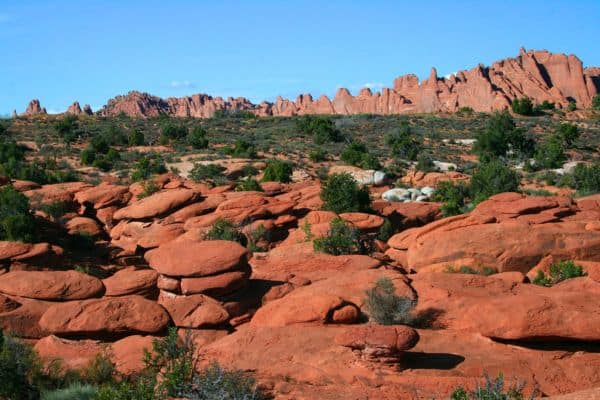
But the landscape isn’t the only story here. The history of human habitation in the area dates back over 10,000 years. The Fremont and Ancient Pueblo people left behind petroglyphs and artifacts that provide a glimpse into their lives and culture.
By the late 1800s, ranchers, farmers, and miners began settling in the region, drawn by its resources and beauty.
It wasn’t until April 12, 1929, that President Herbert Hoover designated the area a national monument. Later, in 1971, it gained its national park status, ensuring the preservation of its wonders for generations to come.
Today, with over 1.5 million visitors annually, Arches National Park continues to be a beacon for those seeking to immerse themselves in a rich tapestry of geological wonders and human history.
Visitors to Arches National Park can enjoy a variety of activities, including hiking, camping, rock climbing, and photography.
The park also has a number of ranger-led programs and events throughout the year. Whether you’re a first-time visitor or a seasoned adventurer, Arches National Park is sure to have something for everyone.
Despite the arid landscape, Arches National Park teems with life. The park acts as a refuge for a variety of desert-adapted animals.
Observant visitors might spot the nimble desert bighorn sheep navigating steep terrain or catch a glimpse of the quick-footed kit fox as it scurries across the sand.
Birds such as the peregrine falcon and canyon wren fill the air with their calls, while beneath the surface, an impressive array of reptiles, including the collared lizard and the whiptail, thrive.
Arches boasts a diverse network of trails catering to adventurers of all skill levels. From the relatively flat and family-friendly trails like the Landscape Arch Trail, which offers up-close views of one of the park’s most iconic arches, to the more challenging Delicate Arch Trail, where hikers are rewarded with panoramic views after a strenuous climb, there’s something for everyone.
Whether you’re seeking solitude or a shared adventure, the park’s trails invite you to step into a world of geological wonders and breathtaking vistas.
Best Times to Visit Arches National Park
Spoiler – We visit Arches every fall. Autumn is less crowded, pleasant weather and the wildlife just comes alive.
Spring (March to May)
Spring is one of the most popular times to visit Arches National Park, and for a good reason. As the snow melts and temperatures begin to rise, the park bursts into life with blooming wildflowers painting the desert landscape.

Daytime temperatures range from 60°F to 80°F, making it comfortable for hiking and exploring. However, with its growing popularity, you can expect larger crowds, especially during weekends and holidays.
It’s advised to start your day early to beat both the crowds and the midday sun.
Summer (June to August):
While summer brings longer daylight hours, it also introduces intense heat with temperatures often soaring above 100°F. Early morning and late afternoon are the best times for outdoor activities.
This season sees a surge in visitors, especially families on school vacations. Remember to carry plenty of water, wear sunscreen, and protect yourself from the sun.
Evening stargazing becomes a favorite activity as the clear desert skies showcase brilliant constellations.
Fall (September to November):
Autumn is another favored time for many visitors. The temperatures mellow down to a pleasant 70°F to 80°F range. As the deciduous trees shed their leaves, they add a splash of color to the already vibrant landscape.
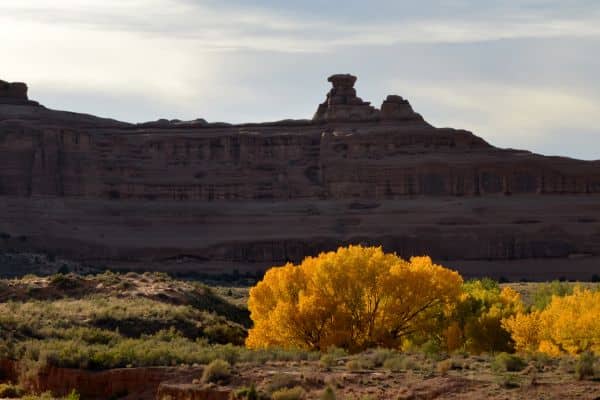
Fall also sees fewer visitors compared to spring and summer, allowing for a more peaceful exploration.
Winter (December to February):
For those seeking solitude, winter is an ideal time. The snow-capped arches and frosted red rocks offer a unique perspective of the park.
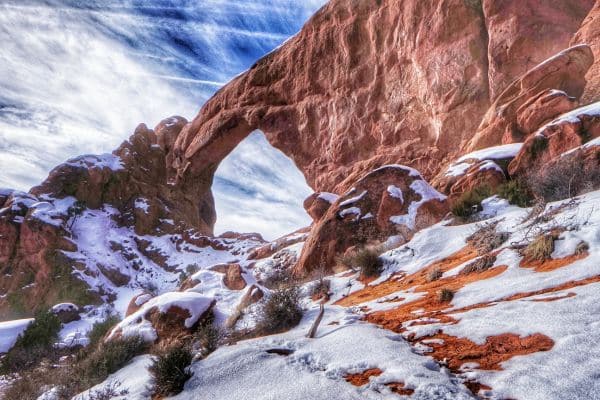
Daytime temperatures hover around 30°F to 50°F, and while many trails remain accessible, some may be closed due to snow or icy conditions.
Ensure you check trail conditions and wear appropriate gear if you plan to visit during this season.
Key Attractions & Must-See Landmarks in Arches National Park
Arches National Park is a treasure trove of geological wonders. But beyond its awe-inspiring arches and vast desert expanses, the park is dotted with numerous landmarks that tell a story of nature’s artistry spanning millions of years.
Each formation, from the majestic towers to the intricate arches, holds a unique tale of evolution, erosion, and time.
Whether you’re a first-time visitor or a returning explorer, these must-see landmarks provide a glimpse into the park’s soul, offering experiences that linger long after the journey ends.
Dive in with us as we journey through the iconic attractions that make Arches National Park an unforgettable destination.
Delicate Arch
Delicate Arch stands as the quintessential symbol of both Arches National Park and the state of Utah. This 60-foot tall freestanding natural arch has become an iconic image, often representing the wild and varied landscapes of the American Southwest.
The arch is situated in the eastern part of the park, with the trailhead originating from the Wolfe Ranch parking area. To get up close to Delicate Arch, you’ll need to tackle a 3-mile round trip hike.
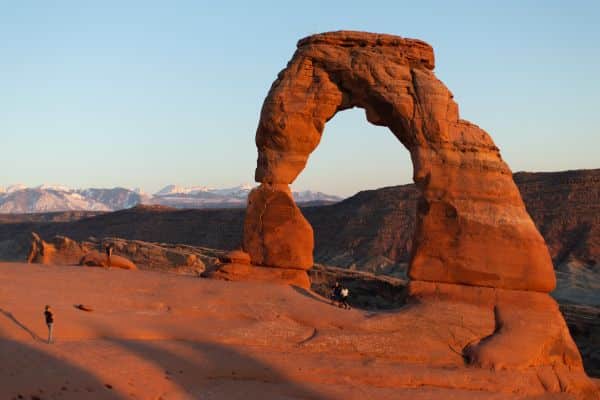
It’s categorized as moderate, but be prepared for sections of steep and slick rock. Considering the trail’s exposure and the lack of shade, we suggest starting the hike either early in the morning or late in the afternoon, especially during hotter months. Always wear sturdy hiking shoes and carry adequate water.
Historically speaking, the arch isn’t just a marvel of nature but holds significant importance in the cultural and artistic realms. It has inspired countless pieces of art, photography, and literature over the years.
The setting of the arch, with the backdrop of the La Sal Mountains, offers an unparalleled vista, especially during sunset when the arch takes on a brilliant reddish hue.
For those who may find the full hike challenging, there’s an alternative. A separate, easily accessible viewpoint provides a more distant, yet still awe-inspiring, perspective of Delicate Arch and is also wheelchair-friendly.
A trip to Arches without witnessing the grandeur of Delicate Arch would be incomplete. We strongly recommend making it a centerpiece of your visit.
Sand Dune Arch
Located in the heart of Arches National Park, Sand Dune Arch offers a distinctively different experience from many of the other arches in the park.
Hidden between tall sandstone fins, this arch provides a sense of seclusion and discovery that many visitors appreciate.
One of the standout features of Sand Dune Arch is the sandy area surrounding it, reminiscent of a desert oasis. The sand here is soft and cool, making it a favorite spot for families with children who often enjoy playing in this natural sandbox.
Plus, the arch and surrounding fins provide shade, making it a cooler destination during the heat of the day.
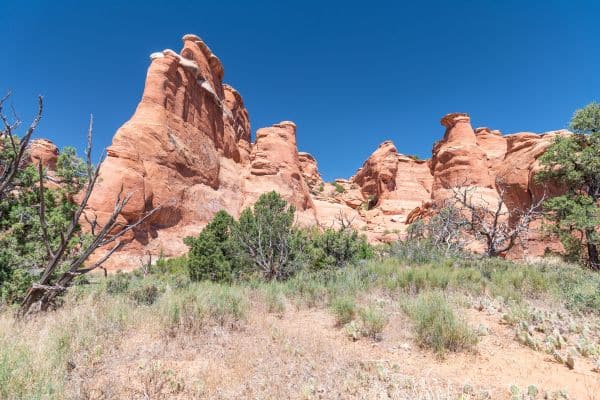
To reach Sand Dune Arch, you’ll embark on an easy, relatively flat 0.3-mile round trip hike starting from the main park road. The trailhead begins at the parking lot near Broken Arch.
As you make your way to the arch, you’ll navigate through a narrow canyon before the landscape opens up to reveal the hidden arch.
What sets Sand Dune Arch apart from many other attractions in the park is its accessibility. It’s suitable for visitors of all ages and physical abilities, making it a popular spot, especially during peak times.
We recommend visiting either early morning or late afternoon to avoid larger crowds and to experience the area’s tranquility.
In planning your visit to Arches National Park, Sand Dune Arch is a testament to nature’s ability to surprise and delight in the most unexpected places. We encourage you to take some time to explore this unique formation and its serene surroundings.
Landscape Arch
Landscape Arch holds the distinction of being one of the longest natural arches in the world. With a span measuring an impressive 306 feet, it’s a testament to the sculpting prowess of natural forces over countless millennia.
Located in the Devils Garden area of Arches National Park, Landscape Arch is a marvel of geology. Its impossibly thin ribbon of rock, supported by two massive stone pillars, challenges our understanding of gravity and resilience.
Over the years, pieces of the arch have fallen, making it a dynamic and ever-changing landmark.

To get to Landscape Arch, you’ll begin at the Devils Garden trailhead, embarking on a relatively flat and well-maintained 1.6-mile round trip trail. The path is straightforward and is accessible to hikers of all skill levels.
Along the way, you’ll be treated to views of several other arches and unique rock formations, but Landscape Arch remains the star attraction.
In recent years, due to the natural erosion process and to ensure visitor safety, the park has restricted access to directly underneath the arch.
However, there are plenty of viewpoints along the trail where you can get an unobstructed view and capture that perfect photo.
When planning your itinerary for Arches National Park, Landscape Arch is an essential stop. Its grandeur and the surrounding landscape showcase the beauty and ephemeral nature of the park’s geologic wonders.
We recommend setting aside ample time to not only visit the arch but also to explore the nearby trails and formations.
Double Arch
Double Arch is a captivating spectacle in Arches National Park, distinct for its two massive arches that share a common base.
This intertwining formation offers visitors a unique perspective on the forces of nature and the myriad ways in which rock can be sculpted over time.
Located in the Windows section of the park, Double Arch was formed differently from most of the park’s other arches. Instead of the typical erosion from water, this arch owes its birth to downward water erosion from atop the rock, leading to its unique structure.
Its formation process and appearance make it a fascinating point of discussion and observation.
Reaching Double Arch is relatively straightforward. From the Windows parking area, it’s a short, easy 0.5-mile round trip on a well-marked trail. This accessibility, combined with the arch’s striking appearance, makes it a popular spot for both daytime visitors and nighttime stargazers.

The lack of significant light pollution in the area means that on clear nights, the arches are silhouetted against a mesmerizing tapestry of stars.
For photographers, Double Arch offers myriad opportunities. The interplay of light and shadow, especially during sunrise and sunset, can result in some breathtaking shots.
Furthermore, the arch’s sheer size – it’s one of the tallest and widest in the park – means that creative angles can produce a wide variety of impressive images.
In your exploration of Arches National Park, we highly recommend spending time at Double Arch.
Its unique formation, combined with its accessibility and the range of viewing and photography opportunities it offers, makes it a must-visit landmark.
Balanced Rock
Balanced Rock, as its name suggests, is a fascinating geological formation that appears to defy logic. Towering over the desert landscape of Arches National Park, this iconic feature consists of a massive boulder precariously perched atop a slender pedestal, creating a visual that captures the imagination of every visitor.
Located near the park’s center and easily visible from the main road, Balanced Rock is one of Arches’ most accessible landmarks. The rock’s total height is about 128 feet, with the balancing boulder itself accounting for 55 feet of this.

The “balancing act” is the result of millennia of erosional forces: while the boulder and its pedestal are made of the same Entrada Sandstone, the pedestal erodes more quickly, creating the appearance of the boulder being delicately balanced.
Visitors can enjoy a close-up view of Balanced Rock by taking a short 0.3-mile loop trail that circles the base of the formation. This trail is flat and suitable for all ages, making it a popular stop for families and individuals alike.
While Balanced Rock is impressive at any time of day, it takes on a special glow during the golden hours of sunrise and sunset. The play of light on the rock’s reddish hues creates a mesmerizing visual contrast against the surrounding landscape.
Photographers often flock to this spot to capture the rock’s silhouette against the backdrop of a setting sun or a starry night sky.
In planning your exploration of Arches National Park, we recommend including Balanced Rock in your itinerary. Its combination of accessibility, striking appearance, and the sheer wonder it evokes make it a highlight of any visit to the park.
Broken Arch
Don’t be misled by its name; Broken Arch is fully intact and stands as one of the more accessible and intriguing formations within Arches National Park. This arch offers a unique blend of beauty and accessibility, making it a favorite among both seasoned hikers and casual visitors.
Located close to the Devils Garden Campground, Broken Arch isn’t actually “broken,” but it has a crack across the top that may give the impression of damage.
This crack, combined with the arch’s distinct shape and orientation, creates an impressive visual spectacle, especially when viewed against the backdrop of the surrounding landscape.
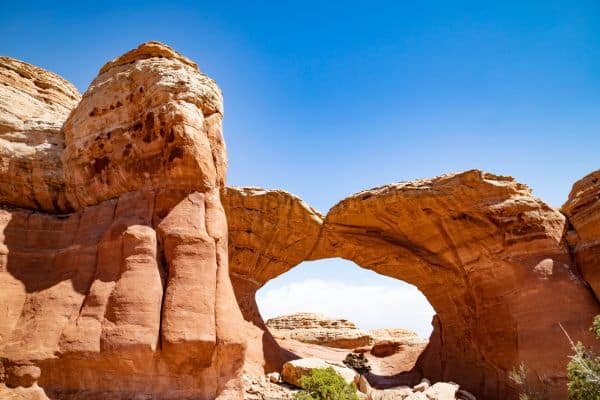
Reaching Broken Arch involves a relatively easy 1.3-mile round trip hike, starting from the Sand Dune Arch parking area. The trail meanders through varied terrain, providing glimpses of other rock formations and the park’s signature red sandstone landscape.
As you approach the arch, you’ll notice its sizeable 60-foot span, which allows for some fantastic photo opportunities.
One of the unique features of Broken Arch is that the trail actually goes through the arch, allowing visitors to experience it from both sides and from underneath. This close-up perspective offers a chance to appreciate the scale and geology of the arch in detail.
For those looking to combine their visit to Broken Arch with other attractions, the trail continues on to Tapestry Arch and the Devils Garden Campground, providing a longer hiking option with more diverse sights.
In your journey through Arches National Park, don’t overlook Broken Arch. Its blend of visual appeal, easy accessibility, and proximity to other attractions makes it a valuable addition to any itinerary.
Fiery Furnace
The Fiery Furnace is not just another formation in Arches National Park – it’s an experience. A dense labyrinth of narrow canyons, towering fins, and hidden arches, the Fiery Furnace is a natural maze that beckons the more adventurous visitors.
Located in the northern section of the park, this area gets its evocative name from the reddish glow the rocks emit during sunset, resembling a furnace’s fiery hues.
The intricate pathways and similar-looking formations can make navigation quite challenging, emphasizing the need for keen observation and a good sense of direction.
Unlike many other areas in Arches, visiting the Fiery Furnace requires a bit more preparation. Due to its complex terrain and the ease with which one can get lost, entry is restricted.
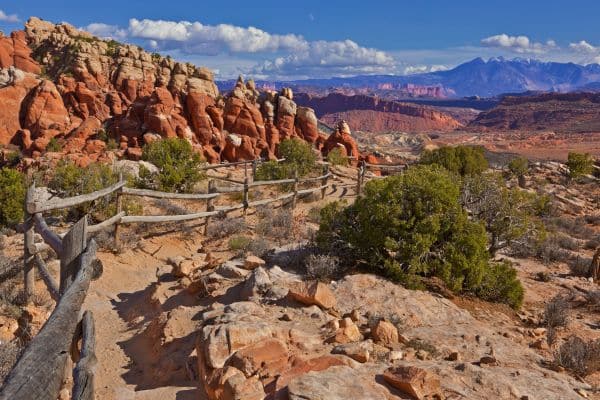
Visitors can explore it in one of two ways: by obtaining a hiking permit for individual exploration or by joining a ranger-led guided tour.
We strongly recommend the latter option, especially for first-time visitors. The ranger-led tours not only ensure safety but also provide a wealth of information about the area’s geology, history, and ecology.
The journey through Fiery Furnace is moderately strenuous, involving climbing, scrambling, and navigating narrow passageways. Proper hiking shoes, ample water, and sun protection are essential.
While Fiery Furnace offers a more challenging experience compared to some other areas in the park, the rewards are immense.
The sense of discovery, the beauty of the hidden arches, and the sheer adventure of navigating this natural maze make it a must-visit for those seeking a more immersive experience in Arches National Park.
Double O Arch
Deep within the Devils Garden section of Arches National Park lies Double O Arch, a unique formation characterized by two stacked arches, one atop the other.
ts intriguing structure and the journey to reach it make Double O Arch a memorable destination for those exploring the park.
The path to Double O Arch is a testament to the park’s diverse terrain. Starting from the Devils Garden trailhead, the hike to this arch spans approximately 4.2 miles round trip.
Along the way, you’ll traverse a mix of sandy paths, slickrock, and some narrow ledges. It’s considered a moderate to slightly challenging hike, especially when navigating the spine or fin sections, which can be narrow with drop-offs on either side.
The reward at the end is a sight to behold. The larger bottom arch spans approximately 71 feet, while the smaller top arch sits directly above it, creating a unique window through which you can view the surrounding landscape.
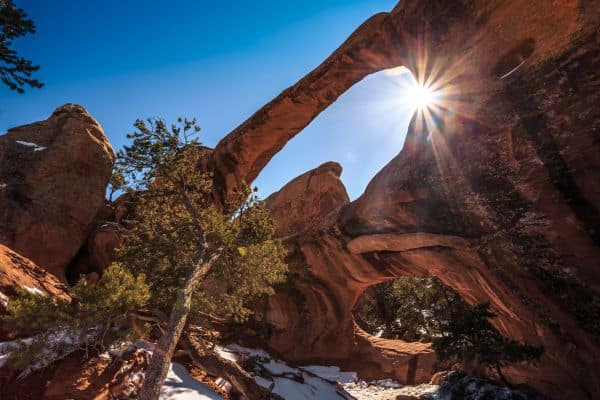
This two-tiered formation is a favorite among photographers, especially in the early morning or late afternoon when the sunlight casts dramatic shadows.
While the arch itself is the primary attraction, the trail leading to it offers additional treats. As you hike, you’ll pass several other notable formations, including Landscape Arch and Partition Arch, allowing for an extended exploration of the park’s wonders.
For those planning a visit to Double O Arch, we recommend carrying sufficient water, wearing sturdy footwear, and starting the hike early to avoid the heat and peak crowds.
The combination of the journey and the destination ensures that a trip to Double O Arch will be one of the highlights of your Arches National Park experience.
Devils Garden
If you’re seeking an area in Arches National Park that encapsulates its diverse range of formations and offers multiple hiking options, then Devils Garden should be high on your list.
As one of the most extensive and varied sections in the park, it’s a hub of trails, arches, and panoramic viewpoints.
Situated at the end of the Arches Scenic Drive, Devils Garden is an expansive area that houses an array of the park’s most famous arches, including Landscape Arch, Double O Arch, and Partition Arch, among others.
The landscape here is a testament to the erosive power of nature, showcasing a plethora of fins, spires, and balanced rocks.
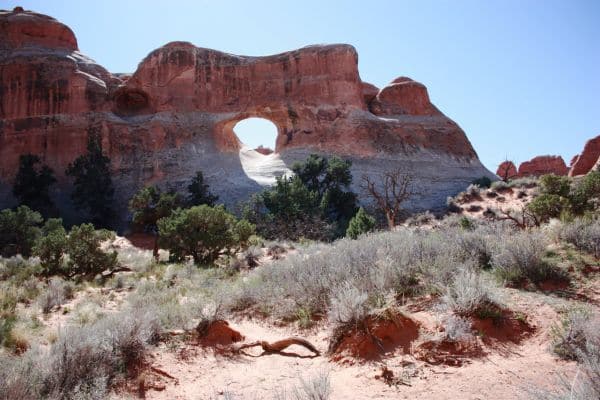
The primary trail in Devils Garden is the Devils Garden Loop, spanning approximately 7.2 miles if you explore all its offshoots.
While the initial section leading up to Landscape Arch is relatively flat and accessible, the trail becomes more challenging as you venture further, especially the Primitive Loop which requires some scrambling and navigation over slickrock.
For those not keen on a long hike, several shorter routes branch off the main trail, leading to individual arches or viewpoints. This modular approach allows visitors to customize their hike based on interest and fitness levels.
While the rock formations are undoubtedly the main draw, don’t forget to appreciate the smaller details. The area is home to diverse desert flora and fauna, and if you’re hiking in the cooler hours, you might even spot some wildlife.
A visit to Devils Garden demands preparation. Due to its popularity, the parking area can fill up quickly, especially during peak seasons. We advise arriving early and ensuring you have ample water, sun protection, and sturdy footwear.
All in all, Devils Garden encapsulates the essence of what Arches National Park has to offer, making it an essential destination for any visitor looking to experience the park’s majesty comprehensively.
Tapestry Arch
Tapestry Arch, though less frequented than some of its renowned counterparts in Arches National Park, offers a uniquely textured visual experience that underscores its name.
This arch, with its intricate patterns reminiscent of woven fabric, showcases nature’s impeccable artistry on sandstone.
Located near the Devils Garden Campground and not far from Broken Arch, Tapestry Arch is accessible via a relatively short and manageable trail.
The path to reach it is about a 0.3-mile round trip, making it an excellent option for those looking for a less strenuous exploration or a quick detour while visiting other nearby attractions.
The arch’s name derives from the intricate patterns and grooves on its surface, resembling threads woven into a tapestry.
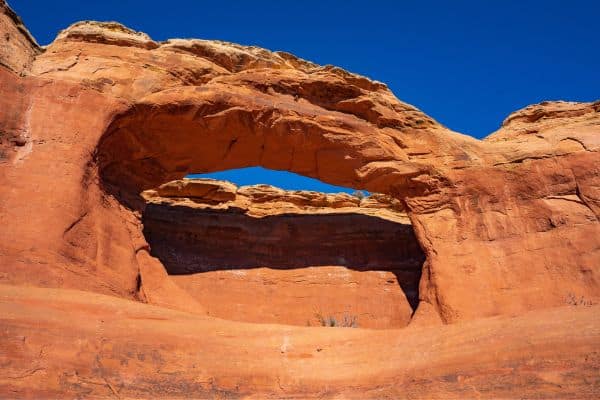
The play of light and shadow across these textures, especially during the golden hours of sunrise and sunset, amplifies its beauty and provides ample opportunities for photography.
In addition to its aesthetic appeal, Tapestry Arch offers a quieter experience. Being slightly off the beaten path, it tends to attract fewer crowds than some of the park’s more famous arches.
This allows for moments of solitude and a chance to appreciate the arch’s beauty without distraction.
For those mapping out their journey through Arches National Park, we recommend making a stop at Tapestry Arch.
Its unique patterns, combined with its accessibility and the serene environment it offers, make it a delightful addition to any park itinerary.
Arches Scenic Drive
One of the best ways to immerse yourself in the grandeur of Arches National Park, especially if time is limited, is by taking the Arches Scenic Drive.
This main artery through the heart of the park offers a continuous panorama of awe-inspiring landscapes, serving as both a destination in itself and a gateway to numerous trailheads and viewpoints.
Stretching for 22 miles one-way, the Arches Scenic Drive starts at the park’s entrance and culminates at the Devils Garden area. As you navigate this paved road, you’ll be treated to sweeping vistas of the park’s vast expanse, punctuated by its iconic arches, towering spires, and vast plateaus.

Each turn and crest offers a new perspective, ensuring that the journey is as rewarding as the destinations it leads to.
Along the drive, well-marked pullouts and parking areas provide access to many of the park’s key attractions. Whether you’re looking to embark on a hike to Delicate Arch, explore the Windows section, or simply pull over to enjoy a picnic with a view, the Arches Scenic Drive facilitates it all.
We recommend setting aside at least a couple of hours to traverse the entire length of the drive, including stops. However, if you’re planning to explore trailheads or partake in longer hikes, consider allocating half a day or more.
Given the drive’s popularity, it can get busy during peak times, especially mid-morning to early afternoon. To avoid congestion and experience the road in a more tranquil setting, consider starting your journey early in the morning or later in the afternoon.
The Arches Scenic Drive is more than just a transportation route—it’s a curated journey through the park’s diverse landscapes and a key component of the Arches National Park experience.
Whether you’re a first-time visitor or a returning enthusiast, this drive offers a fresh perspective on the park’s timeless beauty with every visit.
Turret Arch
Situated in the Windows section of Arches National Park, Turret Arch stands out with its distinctive shape and the dramatic stone “turret” beside it.
As one of the more accessible and visually appealing arches in the park, Turret Arch offers both a rich visual experience and a relatively easy approach for visitors.
Turret Arch is named for its castle-like appearance, with the main archway resembling a giant gateway and the adjacent rock formation taking the shape of a turret or tower.
Spanning roughly 39 feet in width and rising 64 feet in height, the arch offers a grand frame through which you can view the surrounding landscape.

Accessing Turret Arch is straightforward. A short, well-maintained trail leads directly from the Windows parking area, making it a brief 0.3-mile round trip.
Along the way, you’ll enjoy views of the nearby North and South Window Arches, offering a trio of attractions in close proximity to one another.
One of the unique features of Turret Arch is its versatility as a photographic subject. During sunrise, the arch is bathed in a warm, golden light, while sunset casts dramatic shadows across its facade.
In addition, the arch’s positioning allows for stunning nighttime photography, with the moon or stars visible through its expansive opening.
For those charting out their exploration of Arches National Park, Turret Arch is a must-visit. Its combination of visual appeal, easy accessibility, and proximity to other major attractions makes it an essential stop on any park itinerary.
Whether viewed in the soft light of dawn, the fiery hues of dusk, or under a starlit sky, Turret Arch consistently delivers a memorable experience.
Courthouse Towers
In a park renowned for its arches, Courthouse Towers offers a different kind of majesty.
Instead of delicate spans of rock, here you’ll find massive monoliths that soar towards the sky, evoking the grandeur of ancient man-made towers and fortresses.
Located near the park entrance, Courthouse Towers is one of the first significant landmarks visitors encounter upon entering Arches National Park.
This cluster of tall stone columns, aptly named for their resemblance to the spires of stately courthouses, provides a dramatic introduction to the park’s vast array of geological wonders.
The towers are composed of Entrada and Navajo sandstone, and they have been shaped over millions of years by the same erosional forces that created the park’s famous arches.
Among the most notable formations within Courthouse Towers are The Organ, The Tower of Babel, and Sheep Rock. Each of these monoliths has its own distinctive shape and character, providing a wealth of visual interest and photographic opportunities.

A viewpoint and parking area situated directly off the park’s main road offers an excellent vantage point for admiring and photographing Courthouse Towers. Interpretive panels provide insights into the geology and history of the formations, enhancing the visitor experience.
While many visitors to Arches National Park are naturally drawn to its namesake arches, we highly recommend dedicating time to explore and appreciate Courthouse Towers.
Their imposing stature and the stories they tell of geological time and transformation make them an integral and awe-inspiring part of the Arches experience.
La Sal Mountains Viewpoint
Arches National Park is not only about the arches and rock formations; it’s also about the dramatic contrasts between the red rock landscape and the distant mountain ranges. One of the best places to witness this captivating interplay is the La Sal Mountains Viewpoint.
Perched at a strategic location within the park, the La Sal Mountains Viewpoint offers panoramic views of the prominent La Sal Mountain range.
These mountains, the second highest in Utah, rise majestically in the distance, their snow-capped peaks providing a stark contrast to the warm hues of the park’s sandstone formations.
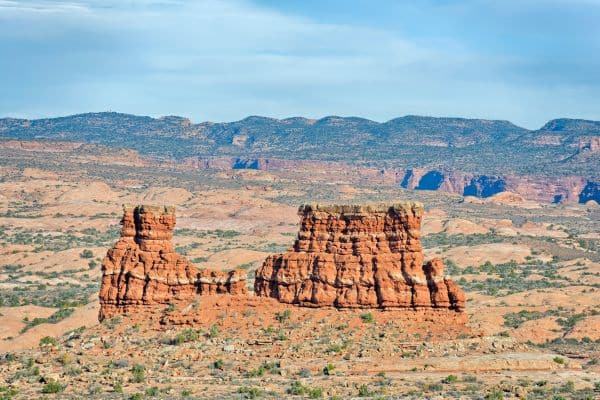
Visitors to this viewpoint are treated to a visual feast that changes with the seasons. In winter and spring, the snow-covered peaks of the La Sals juxtapose beautifully against the red rock foreground.
During summer and fall, the greenery of the mountains offers a refreshing contrast to the arid desert landscape of Arches.
The viewpoint is easily accessible by car, with a designated parking area ensuring visitors can stop and soak in the views.
A series of interpretive panels are available on-site, providing information about the geology of the La Sal Mountains and their significance to the larger Colorado Plateau region.
For photographers, the La Sal Mountains Viewpoint offers a unique opportunity. The interplay of light during sunrise and sunset, combined with the contrasting landscapes, can result in some truly breathtaking shots.
In your journey through Arches National Park, we recommend making a stop at the La Sal Mountains Viewpoint. It serves as a powerful reminder of the diverse landscapes that make this region of Utah so unique and enchanting.
Hiking & Climbing Trails in Arches National Park
Venturing into the wild terrains of Arches National Park on foot is perhaps the most intimate way to connect with its unique geological wonders and vast landscapes.

Whether you’re a casual hiker or an experienced climber, the park offers a range of trails and climbing opportunities to suit all levels of expertise.
Hiking Trails:
Delicate Arch Trail
With a distance of 3 miles round trip, the Delicate Arch Trail leads hikers to the iconic Delicate Arch, arguably the most recognized arch globally and an emblem of Utah.
As one of the park’s most popular trails, it draws countless visitors year-round. For those not keen on hiking the entire distance, there’s also a nearby viewpoint offering a distant but clear sight of the arch.
To avoid the regular crowds and to experience a serene ambiance, consider hiking this trail during winter or aiming for a sunrise view.
Fiery Furnace
A unique 2-mile hike, the Fiery Furnace isn’t just about the distance but the experience. Requiring a ranger guide or a special permit, this trail plunges hikers into a maze-like desert landscape.
Named for the reddish hue the rocks often take on at sunset, this hike is as much about the journey as it is about the destination, with the landscape often resembling a glowing furnace during the golden hour.
Landscape Arch
This trail stretches for 1.6 miles and takes hikers directly to Landscape Arch, the park’s largest arch. As an added bonus, those who take this trail also have the opportunity to detour to two more nearby arches, making it an efficient and rewarding route for those looking to maximize their arch-viewing experience.
Park Avenue
Mimicking the grandeur of its namesake in New York City, the Park Avenue trail is a 2-mile scenic stroll. As hikers navigate this path, they walk in the shadows of towering rock formations, akin to walking beside nature’s skyscrapers. It’s a gentle introduction to the park’s massive formations and is suitable for families and individuals alike.
Windows Primitive Loop
This 1-mile trail provides hikers with an up-close view of three distinct arch formations. Given its short distance and the variety of sights along the way, it’s a favorite among those looking for a brief yet comprehensive hiking experience in the park.
Double Arch
At just 0.8 miles, the Double Arch trail might be short, but it delivers in terms of scenic value. Leading hikers directly beneath a spectacular pair of arches, this route is renowned for the unique rock formations that can be viewed and experienced up close.
Broken Arch
Another trail of 2 miles, the Broken Arch path is a loop that introduces hikers to the beauty of a sandstone arch, allowing them to experience the wonder of Arches National Park in a compact and accessible format.
Double O Arch
Spanning 4.2 miles, this trail takes hikers to a formation where one arch intriguingly sits atop another. It’s a visual spectacle and a testament to the unique geological processes that have shaped the park over millennia.
Devils Garden Primitive Loop
The most challenging hike in the park, this 7.2-mile trail offers solitude and the chance to experience both the Landscape and Double O Arches. Though demanding, the rewards in terms of views and experiences are unparalleled.
Tower Arch
This 3.4-mile trail, ranging from moderate to strenuous, leads to one of the park’s most remote arches. Those who embark on this journey are rewarded with views and a sense of solitude that’s harder to find on some of the park’s more frequented trails.
Backpacking Information
While Arches might not be the first choice for backpackers in the Moab area, the park’s backcountry offers unique opportunities for those seeking solitude.
With four dedicated backcountry camping areas, this challenging terrain demands proper preparation. Before embarking, ensure to obtain the necessary backcountry use permit and be ready to pack in (and out) all essentials.
Protecting the fragile ecosystem is paramount, ensuring that Arches remains an incredible destination for generations to come.
Climbing
Rock climbing in Arches National Park is permitted, but with certain restrictions to protect the delicate formations and the park’s ecosystem.
Climbing on Named Arches: Climbing or scrambling on any named arch within the park is prohibited. This ensures the preservation of these delicate formations.
Bouldering: Limited to established bouldering areas, and any chalk used should be of a color that blends with the native rock.
Fixed Anchors: The installation of new fixed anchors for climbing is prohibited. Existing anchors can be used.
Slacklining or Highlining: This activity is not permitted in the park.
Safety is paramount. Always ensure you have the latest information on trail conditions and any climbing restrictions. Check in at the visitor center for current conditions, potential closures, and additional safety tips.
Wildlife of Arches National Park
Arches National Park, known primarily for its awe-inspiring geologic formations, is also home to a diverse array of plants and animals specially adapted to its desert environment.
From towering trees to elusive mammals, the park offers visitors a unique chance to witness desert life in all its vibrant forms.
Flora
While the red rock landscape might appear harsh and inhospitable, it’s teeming with plant life that has adapted to thrive in its challenging conditions.
The most noticeable among these are the pinion pines and junipers, whose intertwined growth gives them a twisted, sculpted appearance.
These trees not only provide shade and shelter but also sustain many of the park’s animal inhabitants with their seeds and berries.
Other plant species that adorn the park include the blackbrush, Mormon tea, and Indian ricegrass. During spring, Arches transforms with the brief but vibrant bloom of wildflowers such as the claret cup cactus, evening primrose, and scarlet milkvetch, adding splashes of color to the rusty red backdrop.
Fauna
The animal kingdom in Arches National Park is as varied as its plant life. One of the most sought-after sightings is that of the desert bighorn sheep and mountain lions.
These agile creatures have made the rocky terrains of the park their home, and if you’re lucky, you might spot them navigating the steep cliffs with remarkable ease.

From the tiny kangaroo rat to the mighty bison, there are creatures of all shapes and sizes to be found here. And with over 76 different mammal species, Arches National Park really is a wildlife lover’s paradise!
Some of the more popular animals that can be seen in the park include mule deer, elk, bighorn sheep, coyotes, bobcats, and foxes. More rare sightings include mountain lions, black bears, and wild horses.
But it’s not just mammals that thrive in Arches National Park. There are also more than 100 different species of birds that have been spotted here! Some of the most commonly seen birds include eagles, hawks, owls, ravens, and vultures.
And let’s not forget about the reptiles! There are over 50 different types of reptiles that make their home in Arches National Park. From lizards and snakes to turtles and tortoises, there is no shortage of these scaly creatures to be found here.
So whatever your interest, you’re sure to find plenty of fascinating animals and wildlife to discover when you visit Arches National Park!
Rules and Regulations of the Park
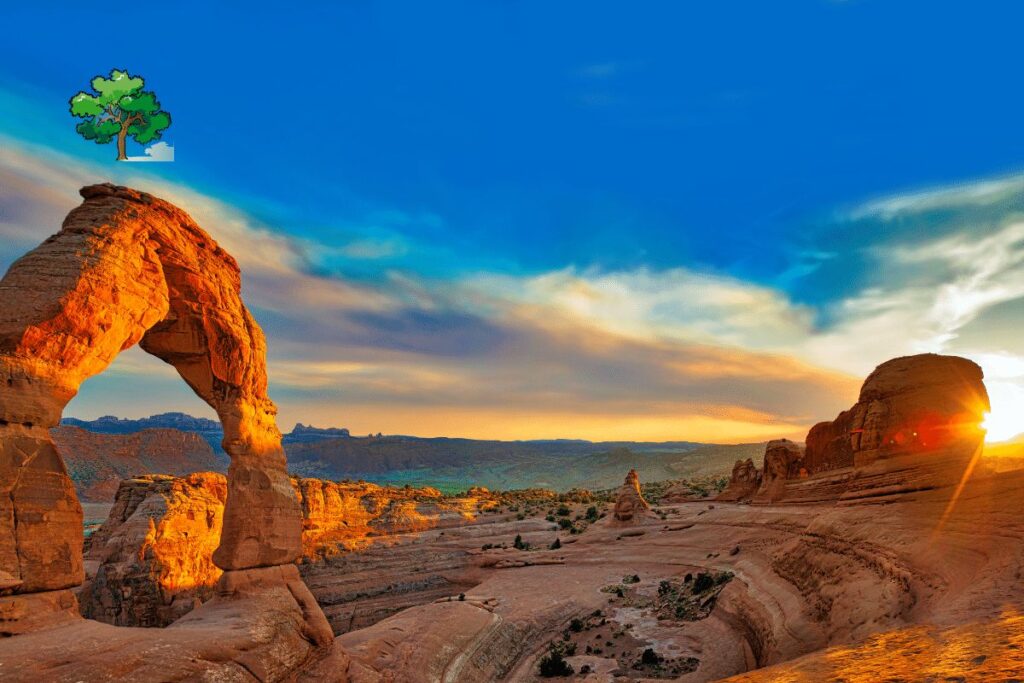
Arches National Park is a place of natural beauty and wonder, and we want to keep it that way! To help protect the park and its resources, please follow these rules and regulations:
– Stay on designated trails and roads. This helps to protect sensitive plants and wildlife.
– Do not collect rocks, leaves, or anything else from the park. Everything in Arches National Park is protected by law.
– Do not feed the animals. Hand-feeding can harm them and cause them to become dependent on humans for food.
– Camp only in designated campgrounds. Backcountry camping is not allowed in Arches National Park.
– Leave your pets at home. Pets are not allowed on trails or in the backcountry of Arches National Park.
– Please be respectful of other visitors and maintain a quiet atmosphere in the park, especially during the early morning and evening hours when wildlife is most active.
Camping & Lodging at Arches National Park
Arches National Park is one of the top camping and lodging destinations in the United States. The park offers a variety of lodging options to suit every taste and budget, from primitive camping to luxury hotels.
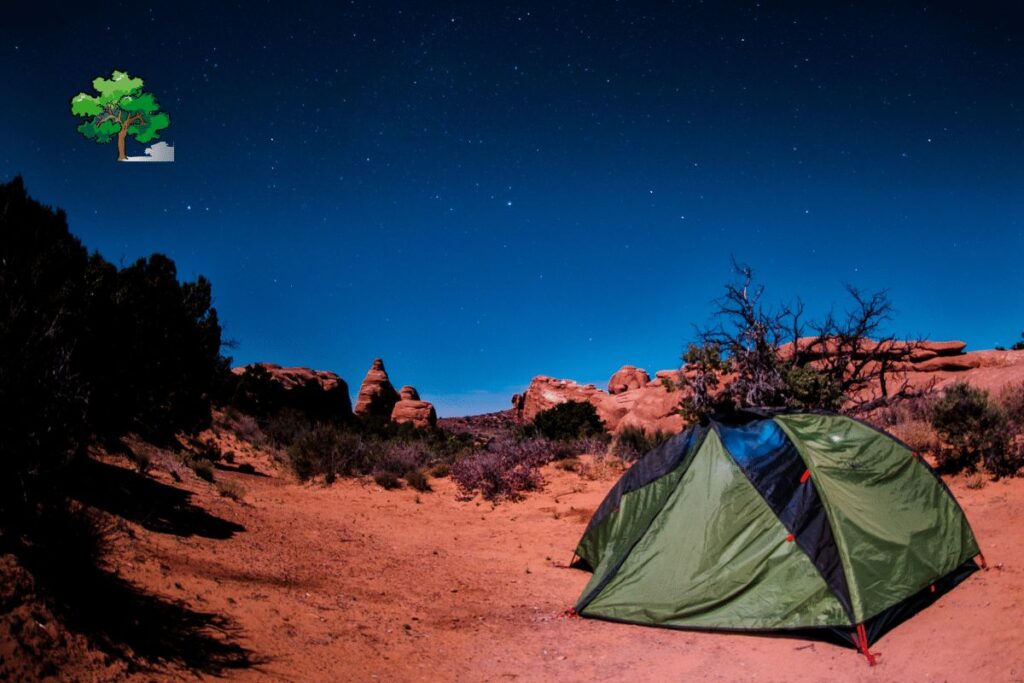
If you’re looking for an affordable and convenient place to stay, the best option is to camp at one of the park’s developed campgrounds. Developed campgrounds offer amenities like running water and flush toilets, and they are typically open year-round.
Campgrounds in Arches National Park
Arches National Park, with its iconic rock formations and diverse ecosystems, provides a unique camping experience. Here, under a canopy of stars, surrounded by ancient stone arches and the sounds of the desert, campers can truly connect with nature. Whether you’re a seasoned camper or a first-timer, the park offers facilities that cater to various needs and preferences.
Devils Garden Campground
The only established campground within Arches National Park, Devils Garden, is situated 18 miles from the park entrance. Nestled deep within a maze of unique rock formations, this campground offers a tranquil setting for campers.
- Basic Info: Devils Garden contains 51 campsites, which are often reserved months in advance, especially during the peak season from March to October. Between November and February, there are 25 sites at Devils Garden Campground, first-come, first-served. Facilities include drinking water, picnic tables, grills, and both pit-style and flush toilets. However, there are no shower facilities on-site.
- Nearby Trails: Located just a stone’s throw away from the campground is the trailhead for the famous Devils Garden Trail. This trail, extending over 7.2 miles, offers views of multiple arches, including Tunnel Arch, Pine Tree Arch, and the breathtaking Landscape Arch. For a more challenging hike, the Primitive Loop can be added, providing a rugged and less-traveled path through the heart of the park.
- Wildlife: The dense concentration of vegetation around the campground, including pinion pines and junipers, attracts a plethora of wildlife. It’s not uncommon for campers to spot mule deer grazing in the early mornings or late afternoons. Birdwatchers might be treated to sightings of canyon wrens or pinyon jays, while the elusive kit fox might make an appearance as dusk settles.
Backcountry Camping
For those seeking a more immersive experience, backcountry camping offers the chance to sleep under the stars in more remote areas of the park.
- Basic Info: Backcountry camping in Arches requires a permit, ensuring that these delicate environments are not overwhelmed by human activity. Unlike the established campgrounds, backcountry sites don’t offer amenities. Campers need to practice Leave No Trace principles, packing out all waste and setting up camp at least one mile from any main road.
- Nearby Trails: Trails leading into the backcountry include the Tower Arch trail, offering a more isolated experience as hikers venture to one of the park’s more remote arches. There’s also the opportunity to chart one’s course, but it’s crucial to research and be prepared for the challenging terrain.
- Wildlife: The seclusion of backcountry camping increases the chances of wildlife encounters. Desert bighorn sheep, often seen on the park’s steeper terrains, might be sighted. Night brings the possibility of hearing the calls of owls or spotting the nocturnal movements of the kangaroo rat.
Tips for Campers
- Reservations: Especially during peak seasons, it’s essential to reserve your spot in advance. Devils Garden Campground can be fully booked months ahead, so plan early.
- Water: While the campground provides drinking water, always bring extra. The desert environment can be dehydrating.
- Weather: Desert climates mean cold nights and scorching days. Prepare with layered clothing and always have a hat and sunscreen.
- Wildlife Safety: Store food securely and maintain a safe distance from wildlife. Remember, you’re a guest in their home.
If you’re looking for a more luxurious experience, there are several hotels located near Arches National Park. One of the most popular hotels in Moab Under Canvas, which offers glamping (glamorous camping) near the park entrance.
For those who prefer traditional accommodations, there are also several hotels in downtown Moab that provide easy access to all of the area’s attractions.
12 Tips When Visiting Arches National Park
- Visit During Off-Peak Times: Arches can get crowded, especially during spring and fall. Consider visiting during the winter months or mid-week to avoid large crowds. Sunrise and sunset are also less crowded and offer spectacular views.
- Stay Hydrated: The desert climate can be deceiving. Even if you don’t feel thirsty, it’s essential to drink water regularly. Always carry more water than you think you’ll need, especially on hikes.
- Respect the Landscape: It’s tempting to venture off the marked paths, but the desert ecosystem is fragile. Stick to designated trails and areas to protect the environment and preserve it for future generations.
- Start Early: Especially in the hotter months, starting your day at dawn can help you avoid the midday heat. Plus, the early morning light provides fantastic photo opportunities.
- Wear Proper Footwear: The terrain in Arches can be rugged and uneven. Invest in a good pair of hiking boots or shoes with solid grip and ankle support.
- Plan for Temperature Swings: Desert temperatures can vary widely between day and night. Layering is key, so pack both light clothing for daytime and warmer layers for the cooler evenings.
- Check Road and Trail Conditions: Natural events can lead to road or trail closures. Before setting out, check with the visitor center or the park’s official website for the latest updates.
- Pack Out Your Trash: With millions of visitors each year, litter can become a significant problem. Always pack out what you pack in, and consider carrying an extra bag to pick up trash left behind by others.
- Book Campgrounds in Advance: If you plan to camp inside the park, make your reservations well in advance, especially during peak seasons.
- Wildlife Safety: Remember that you’re in the home of diverse wildlife. Keep a safe distance, avoid feeding them, and store food securely.
- Night Sky Gazing: Arches offers some of the darkest skies in the U.S. Don’t forget to look up after sunset and, if possible, join a ranger-led star-gazing program.
- Stay Informed: Stop by the visitor center near the park’s entrance. Here, you can get maps, current conditions, and advice tailored to your interests. The rangers are a wealth of information and can help you make the most of your visit.
Arches National Park is a treasure trove of natural wonders. With a bit of planning and respect for the environment, you can ensure your visit is memorable for all the right reasons.
Arches National Park Activities in Winter
The serene beauty of Arches National Park takes on a different allure in the winter months. The contrast of the red rocks dusted with snow and the clearer, cooler atmosphere presents a unique experience for visitors.
While some activities prevalent during the warmer months may not be as accessible, winter in Arches offers its own set of captivating adventures.
1. Winter Hiking:
Many of the park’s trails remain open during the winter, although they might be snow-covered or icy. Popular trails like Delicate Arch and Landscape Arch can be trekked, but always be prepared with proper footwear, such as hiking boots with traction devices, and hiking poles for added stability.
2. Photography:
Winter provides unparalleled photographic opportunities in Arches. The snow-capped arches, stark shadows, and low-angle winter sunlight make for dramatic landscapes that are a photographer’s dream.
3. Stargazing:
The crisp winter air often means clearer skies. Without the haze of summer, winter can be one of the best times for stargazing in the park. Remember to bundle up, as desert temperatures drop significantly after sunset.
4. Ranger-led Programs:
The park rangers often organize winter-specific programs. These can range from guided snowy hikes to educational sessions about the park’s geology and ecology during the colder months.
5. Wildlife Spotting:
Winter is an excellent time for wildlife enthusiasts. Many animals are active during the cooler temperatures, and the snow provides an opportunity to spot and identify animal tracks, from small critters like rabbits to larger mammals like mule deer.
6. Cross-Country Skiing and Snowshoeing:
While Arches doesn’t have designated cross-country skiing routes, when there’s sufficient snowfall, many visitors enjoy skiing on the park roads or the gentler trails. Snowshoeing is another popular activity, offering a unique way to traverse the snowy landscape.
7. Winter Camping:
For the truly adventurous, winter camping in Arches can be a magical experience. The Devils Garden Campground remains open year-round, though services are limited. The stillness of a winter night in the desert is an experience like no other.
8. Scenic Drives:
The park’s main roads are usually plowed soon after significant snowfalls, making winter drives a viable and mesmerizing activity. The contrast of the white snow against the red rocks, especially during the golden hours of sunrise and sunset, is breathtaking.
Tips for a Safe Winter Visit:
- Stay Updated: Check the park’s official website or contact the visitor center for the latest on road and trail conditions.
- Pack Wisely: Layered clothing, extra food, water, and emergency supplies are crucial. The winter desert can be both cold and dry.
- Stay Aware: Icy patches can be hidden under fresh snow, both on roads and trails. Move cautiously and prioritize safety.
Winter in Arches National Park offers a tranquil, less-crowded, and altogether different experience from the bustling summer months. Embrace the chilly temperatures, prepare adequately, and the park’s winter wonders will unfurl before you.
Conclusion
Arches National Park is one of the most stunning and breathtaking outdoor spaces our country has to offer. With its dramatic sandstone arches, towering red rock spires, lush canyons and hidden oases, it truly captures the essence of nature in all its beauty. Now that you know more about Arctics National Park – from how to plan your trip to what activities you can enjoy once there- we hope this guide will help you get ready for a perfect visit!

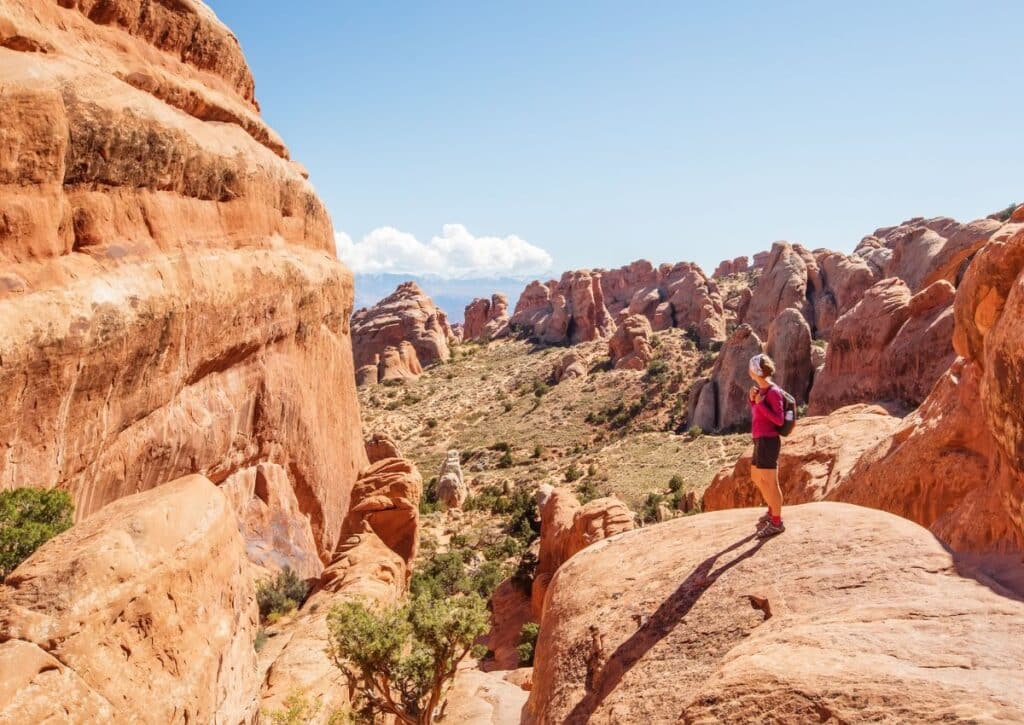


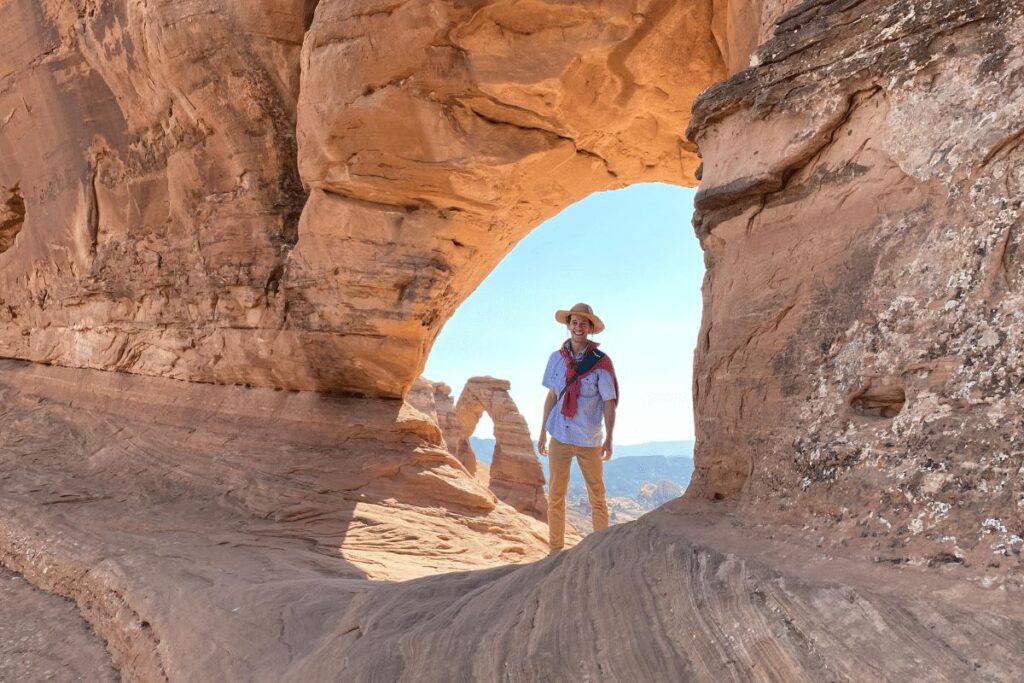
The guide provides a comprehensive overview of the park and its highlights, making it a perfect resource for those planning to visit. The information on the different trails, the delicate arch, and the park’s history is presented in an easy-to-understand manner, and the photographs are simply breathtaking.
I particularly liked the section on the best time to visit the park. Your advice on avoiding peak season and going during spring or fall to enjoy the park in peace is spot on. The information on the different camping options available in the area is also very useful, especially for those looking for a more immersive experience.
In conclusion, I must say that your article has left me with a strong desire to visit Arches National Park. Your writing style and the attention to detail are truly remarkable, and I hope to read more of your work in the future. Thank you for sharing this informative and engaging guide!